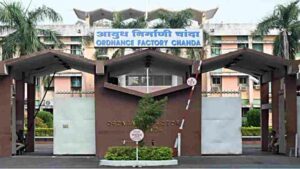PROJECT NAME
ORDNANCE ACTORY, CHANDA, MAHARASHTRA, INDIA
OVERVIEW

Indian Ordnance Factories are the oldest and largest industrial setup and forms an integrated base for indigenous production of defense hardware and equipment, with the primary objective of self-reliance in equipping the Indian armed forces with state-of-the-art battlefield equipment. The Indian Ordnance Factories possess the unique distinction of over 200 years of experience in defense production. The Ordnance Factories in India predates even institutions like the Indian Army by over a century. Telematics can be extremely beneficial in optimizing vehicle movement within ordnance factories. There are a lot of security concerns due to the payloads that gets carried in the convoy. The defense convoys have their own special laid down requirements that must be followed strictly. There are inherent threats of attack on the convoy.
SOLUTION & IMPLEMENTATION

1. Fleet Management: Telematics systems were installed in all vehicles used by the ordinance factory for movement of payloads. These systems were tracked the real-time location, speed, and route taken by each vehicle. Fleet managers could monitor this information on a centralized dashboard, allowing them to optimize vehicle allocation and route planning. By ensuring that vehicles take the most efficient paths and minimizing idle time, telematics has reduce fuel consumption and vehicle wear and tear.
2. Security and Geofencing: Telematics systems can also enhance security by providing detailed insights into vehicle movements. Authorized personnel can access real-time information about which vehicles are entering or leaving the geofence and at what times. This can help prevent unauthorized access and detect any suspicious activity. The technology also ensures that the pre-determined routes are followed and any deviation is reported.
3. Maintenance Scheduling: Telematics data was used to track vehicle usage and performance metrics, such as engine hours and mileage. By analyzing this data, maintenance schedules can be optimized to minimize downtime and reduce the risk of unexpected breakdowns. Preventive maintenance tasks can be automatically scheduled based on factors such as vehicle usage patterns and engine diagnostics, ensuring that vehicles remain in optimal condition.
4. Safety Monitoring: Telematics systems also contribute to improving safety. Real-time monitoring of vehicle speed and driving behavior can help identify instances of reckless driving or violations of safety protocols. Alerts can be sent to supervisors in case of speeding or harsh acceleration, allowing them to take immediate action to prevent accidents and ensure compliance with safety regulations.
5. Performance Analysis: Over time, telematics data has been used to conduct comprehensive performance analysis of the entire fleet. By analyzing factors such as fuel efficiency, route efficiency, and vehicle utilization, fleet managers were able to identify areas for improvement and implement strategies to optimize overall operational efficiency. This data-driven approach has lead to cost savings and productivity gains over the long term.
ACHIEVED OUTCOME
In summary, the integration of telematics systems into vehicle movement within ordinance factories provided numerous benefits, including improved fleet management, enhanced security, optimized maintenance scheduling, increased safety, and better overall performance analysis. By leveraging real-time data and analytics, ordinance factories were able to streamline their operations and achieve higher levels of efficiency and effectiveness.

